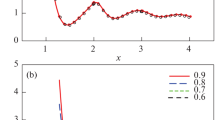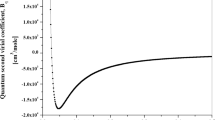Abstract
A variational theory (VT), in which the potential energy of a real system is evaluated relative to the hard-sphere system, has been used to investigate the medium's effects on the pair potential parameters. By adding the medium's effects to the isolated pair potential, the concept of an “effective pair potential” (EPP) has been introduced. The advantage of such a potential (EPP) over the isolated pair potential is that the configurational energy can exactly be written as the sum of all EPP of all pairs available in the system. The parameters of such a pair potential will then show state dependence. The EPP parameters for different dense fluids at various temperatures have been obtained via the VT, and they have been shown to be density independent for densities greater than the Boyle density, ρ B ≃1.8ρ c , (where ρ c is the critical density), while at lower densities the parameters depend on density as well as temperature. For any dense fluid, the depth of the EPP, ε, is found to be larger than its corresponding isolated pair. When the EPP parameters are used to reduce temperature and density, the cut-off parameter, C=d/σ depends only on the reduced density, and this parameter shows a strong principle of corresponding states for different fluids. The resulting expression for the cut-off parameter has then been used to accurately predict the internal energy. Finally, the EPP parameters are compared with those of the average effective pair potential (AEPP) for Ar, to show the importance of the medium effects and the long-range interactions of the AEPP in dense fluids, individually. This comparison shows that the depth parameter of the AEPP is much larger than that of the EPP. Since the long-range interactions are mainly attractive, such a conclusion is reasonable.
Similar content being viewed by others
REFERENCES
G. A. Parsafar, F. Kermanpour, and B. Najafi, J. Phys. Chem. B 103:7287(1999).
R. W. Zwanzig, J. Chem. Phys. 22:1420(1954).
G. A. Mansoori and F. B. Canfield, J. Chem. Phys. 51:4958(1969).
G. A. Mansoori and F. B. Canfield, J. Chem. Phys. 51:5335(1969).
G. A. Mansoori and F. B. Canfield, J. Chem. Phys. 51:4967(1969).
Y. Rosenfeld, J. Chem. Phys. 73:5760(1980).
G. A. Mansoori, in Proc. 7th Symposium on Thermophysical Properties (ASME, New York, 1977), p. 442.
Y. Rosenfeld and A. Bara, J. Chem. Phys. 75:427(1981).
Y. Rosenfeld, Phys. Rev. A 15:2545(1977).
G. I. Kerley, Los Alamos Sci. Lab., Rep. LA-4760(1971).
D. Stroud and N. W. Ashcroft, Phys. Rev. B 5:371(1972).
I. H. Umar, A. Meyer, M. Watabe, and W. Young, J. Phys. Metal Phys. 4:1691(1974).
G. A. Mansoori, C. Jedrzejek, N. J. Shah, and M. Blander, in Chemical Metallurgy— A Tribute to Carl Wagner (The Metallurgical Society of AIME, New York, 1981), p. 233.
C. Jedrzejek and G. A. Mansoori, Acta Phys. Pol. A 56:583(1979).
C. Jedrzejek and G. A. Mansoori, Acta Phys. Pol. A 57:107(1980).
A. Alem and G. A. Mansoori, AIChE J. 30:468(1984)
A. Alem and G. A. Mansoori, AIChE J. 30:1984ibid, 475.
D. A. McQuarrie, in Statistical Mechanics (Harper Collins, New York, 1975).
N. F Carnahan and K. E. Starling, J. Chem. Phys. 51:635(1969).
R. T Jacobson and R. B. Stewart, J. Phys. Chem. Ref. Data 18:639(1989).
W. Wagner and U. Stezmann, J. Phys. Chem. Ref. Data 20:1061(1991).
B. A. Younglove and J. F. Ely, J. Phys. Chem. Ref. Data 16:642(1987).
G. A. Mansoori and I. Ali, The Chem. Eng. J. 7:173(1974).
L. L. Lee, in Molecular Thermodynamics of Nonideal Fluids (Butterworths, Boston, 1988), p. 219.
J. Millat, J. H. Dymond, and C. A. Nieto de Castro, in Transport Properties of Fluids, 1st edn. (Cambridge University Press, 1996), p. 76.
Author information
Authors and Affiliations
Corresponding author
Rights and permissions
About this article
Cite this article
Kermanpour, F., Parsafar, G.A. & Mansoori, G.A. Investigation of the Temperature and Density Dependences of the Effective Pair Potential Parameters Using Variational Theory. International Journal of Thermophysics 25, 187–203 (2004). https://doi.org/10.1023/B:IJOT.0000022334.03940.b2
Issue Date:
DOI: https://doi.org/10.1023/B:IJOT.0000022334.03940.b2




